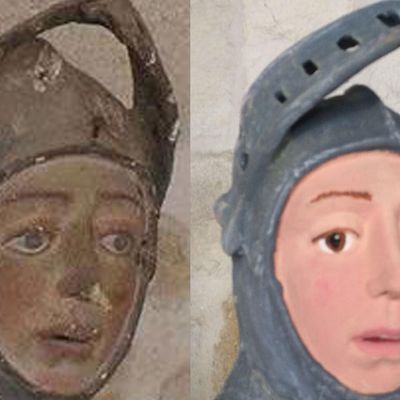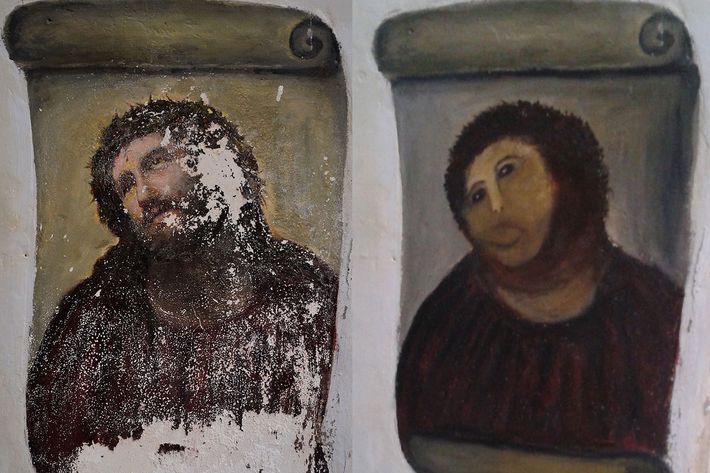
Do you remember the restoration of Ecce Homo? The 19th-century painting by artist Elías García Martínez was given a fresh coat of paint in 2012 by an 81-year-old amateur, well-intentioned (or was she?) art restorationist in the Spanish city of Borja, turning it instantly from fresco to oh no. Perhaps a photo would jog your memory:

Ah, yes. At the time, city councilor Juan María de Ojeda said the woman had acted “spontaneously and with good intentions.” An interesting theory.
On Tuesday, the world got word of a second Catholic restoration disaster, this time in the Spanish town of Estella, about 78 miles southeast of Borja. Hm. Perhaps it is simply a coincidence that Matthew 7:8 reads, “For everyone who asks receives; the one who seeks finds; and to the one who knocks, the door will be opened.”
Or is it?
In this restoration blunder, a 16th-century polychrome statue of Saint George was restored to look more like a 21st-century statue of a Michael Cera–type, dressed for a knight-themed costume party. According to The Guardian, “The restoration is believed to have been carried out by a handicrafts teacher at the request of the parish authorities of the Church of St Michael.”
Koldo Leoz, the mayor of Estella, told The Guardian, “The parish decided on its own to take action to restore the statue and gave the job to a local handicrafts teacher. The council wasn’t told and neither was the regional government of Navarre.” Interesting. Leoz said both the wrong plaster and the wrong paint were used, possibly covering up the original layers of paint beyond repair. “This is an expert job; it should have been done by experts,” he said.
Perhaps it was.
Two art restorations gone awry in two Spanish churches, within a few years of each other — are you connecting the dots as I am? Or perhaps you believe flubbed restorations simply happen this frequently on their own. Hm. As someone who has never read nor seen The Da Vinci Code, this sounds to me like something similar to The Da Vinci Code, which I believe was about how Jesus was a woman though genuinely I forget and the person I asked for confirmation did not know.
Could it be that these “amateur restorationists” — this handicrafts teacher, this 81-year-old woman — are in fact pawns in a much larger game? Could it be that they were hired at a high price or perhaps through blackmail for the sake of covering up some of the church’s most explosive ancient secrets, the clues to which are hidden in art throughout Spain — art that must be destroyed?
I believe the answer is yes.
The secrets?
Well, they’re up to us to find out. Before it’s too late.

